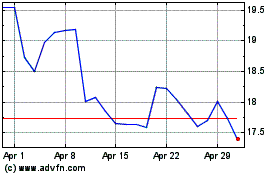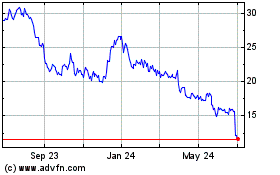By Jared S. Hopkins
More patients are turning to mail or courier to get their
prescription drugs during coronavirus lockdowns, a shift from the
traditional visit with a pharmacist that is expected to endure
after the pandemic subsides.
While waiting out California's stay-at-home order in March on
his brother's house boat near San Francisco, Rich Goldman exhausted
his supply of cholesterol and blood-pressure drugs. So he found an
online pharmacy that would ship the drugs to him.
"I didn't want to venture out if I could avoid it," said Mr.
Goldman, a 60-year-old marketing employee. He said the pharmacy,
Genius Rx, sent his prescriptions within several days.
During the last week of March, mail-order prescriptions grew 21%
from the previous year to bring their share of the prescription
drug market to 5.8%, the highest share in at least two years,
according to data from SunTrust Robinson Humphrey analyst Gregg
Gilbert.
Drugmaker Eli Lilly & Co., which sees about one-quarter of
its U.S. business ship by mail, said more of its products have been
processed that way during the pandemic. Pfizer Inc. said that for
patients in its assistance program, it is sending more medicines
directly and extending shipments from 30-day to 60-day
supplies.
"It's clear that the old model from three months ago probably
won't simply resume," said Stephen Eckel, an associate dean at the
University of North Carolina Eshelman School of Pharmacy.
The increase in mailed prescription drugs is among several
changes sweeping through medicine as a result of the coronavirus
pandemic, including expanded use of virtual doctor visits. Experts
predict many of the changes will become permanent, reshaping
care.
Filling prescriptions in person won't disappear, industry
experts said. A trip to the pharmacy has been a staple for decades,
and many patients with several prescriptions prefer to rely on
their neighborhood pharmacist. Whenever the pandemic ends, a
significant number of customers are expected to return to
stores.
Visits to the pharmacy account for the bulk of the 3.8 billion
prescriptions filled each year in the U.S. Prescription-drug sales
at pharmacies totaled $336 billion in 2018, according to the most
recent data from health-research firm Iqvia Holdings Inc.
Yet the longtime practice has been ripe for a makeover, just
like the one retail has experienced. Younger patients, with fewer
prescriptions and accustomed to ordering online, are likely to
embrace the change and stick with it, industry experts said.
Increased use of mail-order pharmacies could spell trouble for
independent bricks-and-mortar drugstores, they said.
Locally owned pharmacies have already been struggling to compete
against national chains, a situation made worse as some health
plans and drug-benefit managers steer patients to large mail-order
pharmacies.
To compete, many local pharmacies have ramped up their own
mail-order and home-delivery services during the pandemic, said
Douglas Hoey, Chief Executive Officer of the National Community
Pharmacists Association, a trade group. He said many patients
prefer interacting with pharmacists and worry about their medicines
arriving on time.
To protect their bricks-and-mortar stores, the big chains had
sought to discourage use of mail-order pharmacies by, among other
things, giving health plans discounts on drug prices. In recent
years the chains set up their own mail-order operations, which
stand to benefit now.
AllianceRx Walgreens Prime, a joint venture between retailer
Walgreens Boots Alliance Inc. and Prime Therapeutics LLC, a
pharmacy-benefits manager owned by health insurers, counts 15% more
home-delivery customers and 20% more volume since Jan. 1, with most
of the growth occurring after the coronavirus pandemic hit the
U.S.
The new customers wanted to try home delivery because they
weren't leaving their homes, while existing customers were stocking
up on medicines, AllianceRx Walgreens Prime CEO Joel Wright said.
He said the firm has hired about 200 new employees to meet the new
demand.
"I don't think we'll see the entire increase remain, but I do
think we've seen a notable shift in the business," Mr. Wright
said.
The shift could benefit new entrants to the pharmacy market such
as Amazon.com Inc., said Adam Fein, CEO of the Drug Channels
Institute, which provides research on the drug-supply chain. Amazon
bought the online pharmacy PillPack in 2018.
Honeybee Health Inc., a startup pharmacy in Culver City, Calif.,
that mails prescription drugs to patients who aren't using
insurance, is processing about 3,000 prescriptions a day, up 50%
since early March, said co-founder Jessica Nouhavandi.
Capsule Corp., which provides same-day delivery by courier in
New York City, is seeing a fivefold weekly increase in new
customers since early March, said CEO Eric Kinariwala. To keep up,
employee count has nearly doubled to more than 800, and the firm in
April accelerated expansion to Chicago and other cities.
"Doctors are saying to patients, 'Don't come in if you think you
have the flu, but also, 'Don't go into the pharmacy,'" he said.
Increased use of mail-order pharmacies has been a long time in
coming. Their primary customers have been patients with cancer and
other diseases who take drugs that are expensive, can't simply be
swallowed and may require special storage.
As use of cancer and other specialty drugs has increased, mail
pharmacies have started taking off, capturing more than half of the
industry's prescription revenue growth over the past six years,
said Mr. Fein of the Drug Channels Institute.
Mail-order prescriptions also found demand, as online pharmacies
used lower prices to appeal to patients concerned about drug
costs.
The coronavirus pandemic accelerated that increase. New
customers, forced to use more digital services, turned to
mail-order pharmacy apps and websites for prescriptions, while
pharmacies expanded their delivery areas.
Some states and health plans waived refill limits to encourage
patients to get 90 days of drug supplies, instead of 30 days. And
pharmacies waived delivery fees.
CVS Health Corp. saw a 10-fold increase in pharmacy home
deliveries during the first-three months of this year, mostly since
waiving fees in early March, a spokesman said. Express Scripts, a
subsidiary of insurer Cigna Corp., said it is processing more
home-delivery orders since stay-at-home measures began in March.
Walgreens is also seeing a boost in demand for prescription
delivery during the pandemic, a spokesman said.
Write to Jared S. Hopkins at jared.hopkins@wsj.com
(END) Dow Jones Newswires
May 12, 2020 07:14 ET (11:14 GMT)
Copyright (c) 2020 Dow Jones & Company, Inc.
Walgreens Boots Alliance (NASDAQ:WBA)
Historical Stock Chart
From Mar 2024 to Apr 2024

Walgreens Boots Alliance (NASDAQ:WBA)
Historical Stock Chart
From Apr 2023 to Apr 2024
